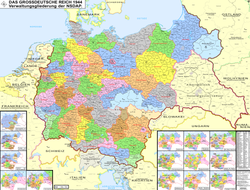Gau Electoral Hesse
| Gau Electoral Hesse | |||||
| Gau of Nazi Germany | |||||
|
|||||
|
Flag |
|||||
| Capital | Kassel | ||||
| Gauleiter | |||||
| • | 1927–1928 | Walter Schultz | |||
| • | 1928–1943 | Karl Weinrich | |||
| • | 1943–1944 | Karl Gerland (acting) | |||
| • | 1944–1945 | Karl Gerland | |||
| History | |||||
| • | 1927 | ||||
| • | Disestablishment | 8 May 1945 | |||
| Today part of |
|
||||
Flag
The Gau Electoral Hesse (German: Gau Kurhessen) was an administrative division of Nazi Germany from 1933 to 1945 the northern parts of the Prussian province of Hesse-Nassau. Before that, from 1927 to 1933, it was the regional subdivision of the Nazi Party in that area.
The Nazi Gau (plural Gaue) system was originally established in a party conference on 22 May 1926, in order to improve administration of the party structure. From 1933 onwards, after the Nazi seizure of power, the Gaue increasingly replaced the German states as administrative subdivisions in Germany. The Gau was originally part of the Gau Hesse (German: Gau Hessen) which was split into north and south in 1927. In 1934 the Gau Hesse-Nassau Nord was reorganised and renamed Gau Electoral Hesse.
At the head of each Gau stood a Gauleiter, a position which became increasingly more powerful, especially after the outbreak of the Second World War, with little interference from above. Local Gauleiter often held government positions as well as party ones and were in charge of, among other things, propaganda and surveillance and, from September 1944 onward, the Volkssturm and the defense of the Gau.
The position of Gauleiter in Electoral Hesse was originally held by Walter Schultz from 1927 to 1928, followed by Karl Weinrich from 1928 to 1943. Karl Gerland succeed Weinrich, initially in an acting position before becoming Gauleiter in 1944. Gerland was killed in action in April 1945. Weinrich, his predecessor who was removed from his position because of incompetence during a bombing raid on Kassel, survived the war, was sentenced to a ten year prison term in 1949 and died in 1973.
...
Wikipedia


